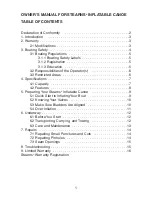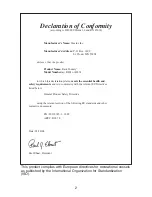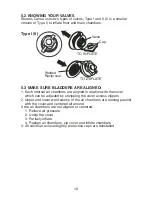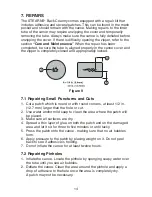
11
5.4 OVER-INFLATION
Do not over-inflate the canoe. Over-inflation is the primary
cause of leaks. Inflate the canoe until most of the wrinkles in
the fabric are gone and it feels firm to the touch, but do not
exceed 1.75 psi (0.12 bar) in the main air chambers and 1.0 psi
(0.07 bar) in the floor chamber.
Water temperature and weather affect the air pressure in the
boat. In cold weather your canoe will lose some pressure
because the air will contract. If this occurs, you may want to
add more air to improve your boat’s performance. In hot
weather, the air will expand. You must let out some air to
prevent the boat from failing from over pressure. Avoid
exposing your canoe to extreme temperatures (hot or cold).
On warm sunny days, keep the canoe either in water or in
shade (if kept inflated on land). This will avoid expanding
chambers due to rise in temperature which can result in seam
tears, delamination, popped
I
-Beams and pinholes. Also keep
in mind to avoid asphalt, sand, pebbles or concrete in direct
sunlight as they radiate high ground heat.
Check for proper inflation often. Use your thumb to press on the port
(left) and starboard (right) air chambers. You should be able to press
down 3/4 in. (19 mm). The chamber should feel firm without too much
resistance.
If you have difficulty achieving 3/4 in. (19 mm), the chamber could be
over inflated.
If you are easily able to press further than 3/4 in. (19 mm), the chamber
could be under inflated.
Before paddling, be sure all the canoe's air chambers are properly
inflated.
DO NOT overload your canoe which exceeds the rating on the
capacity plate. Overloading a canoe can result in loss of
control and an unsafe canoe. If your canoe has no capacity
plate, contact the selling dealer or the manufacturer.














































